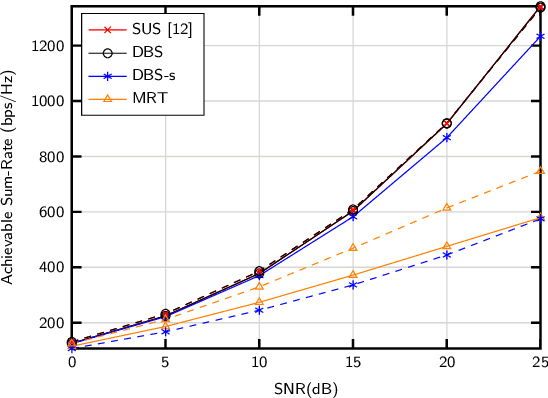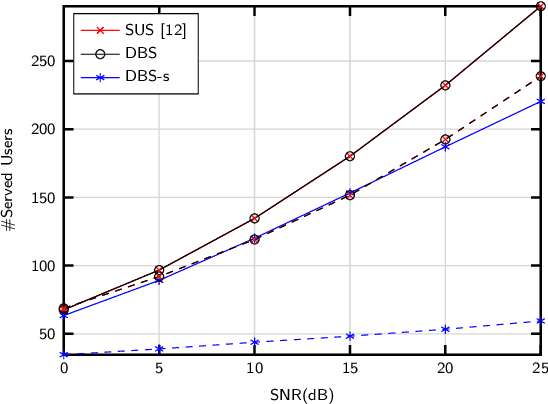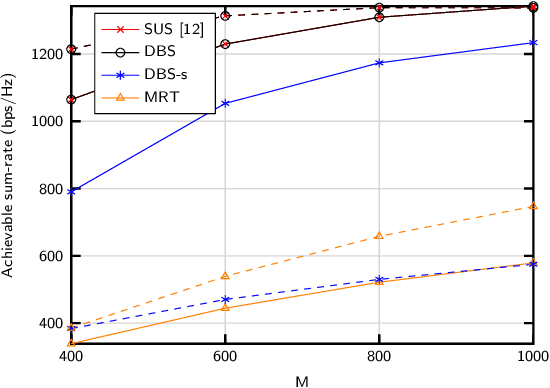Luis Castedo
University of A Coruña
Direct Antenna Frequency-Hopped M-FSK Modulation With Time-Modulated Arrays
Feb 05, 2024Abstract:We present an innovative approach that simultaneously enables direct antenna frequency-hopped M-ary frequency shift keying (DAFH-MFSK) modulation and beamsteering through the use of time-modulated arrays (TMAs). The distinctive feature of our approach lies in the modulation of the TMA excitations with binary periodic sequences, which can be easily frequency-adjusted and time-delayed to simultaneously allow for DAFH-MFSK direct antenna modulation and beamsteering. Notably, our TMA proposal offers a distinct advantage over conventional architectures in terms of performance metrics, including reduced insertion losses and enhanced phase resolution for beamsteering, while also simplifying hardware complexity.
* 5 pages, 7 figures, published in IEEE Antennas and Wireless Propagation Letters as open access article
Deep Contextual Bandit and Reinforcement Learning for IRS-Assisted MU-MIMO Systems
Jan 30, 2024Abstract:The combination of multiple-input multiple-output (MIMO) systems and intelligent reflecting surfaces (IRSs) is foreseen as a critical enabler of beyond 5G (B5G) and 6G. In this work, two different approaches are considered for the joint optimization of the IRS phase-shift matrix and MIMO precoders of an IRS-assisted multi-stream (MS) multi-user MIMO (MU-MIMO) system. Both approaches aim to maximize the system sum-rate for every channel realization. The first proposed solution is a novel contextual bandit (CB) framework with continuous state and action spaces called deep contextual bandit-oriented deep deterministic policy gradient (DCB-DDPG). The second is an innovative deep reinforcement learning (DRL) formulation where the states, actions, and rewards are selected such that the Markov decision process (MDP) property of reinforcement learning (RL) is appropriately met. Both proposals perform remarkably better than state-of-the-art heuristic methods in scenarios with high multi-user interference.
A Rank-Constrained Coordinate Ascent Approach to Hybrid Precoding for the Downlink of Wideband Massive (MIMO) Systems
Jan 30, 2024Abstract:An innovative approach to hybrid analog-digital precoding for the downlink of wideband massive MIMO systems is developed. The proposed solution, termed Rank-Constrained Coordinate Ascent (RCCA), starts seeking the full-digital precoder that maximizes the achievable sum-rate over all the frequency subcarriers while constraining the rank of the overall transmit covariance matrix. The frequency-flat constraint on the analog part of the hybrid precoder and the non-convex nature of the rank constraint are circumvented by transforming the original problem into a more suitable one, where a convenient structure for the transmit covariance matrix is imposed. Such structure makes the resulting full-digital precoder particularly adequate for its posterior analog-digital factorization. An additional problem formulation to determine an appropriate power allocation policy according to the rank constraint is also provided. The numerical results show that the proposed method outperforms baseline solutions even for practical scenarios with high spatial diversity.
Alternating Minimization for Wideband Multiuser IRS-aided MIMO Systems under Imperfect CSI
Jan 29, 2024



Abstract:This work focuses on wideband intelligent reflecting surface (IRS)-aided multiuser MIMO systems. One of the major challenges of this scenario is the joint design of the frequency-dependent base station (BS) precoder and user filters, and the IRS phase-shift matrix which is frequency flat and common to all the users. In addition, we consider that the channel state information (CSI) is imperfect at both the transmitter and the receivers. A statistical model for the imperfect CSI is developed and exploited for the system design. A minimum mean square error (MMSE) approach is followed to determine the IRS phase-shift matrix, the transmit precoders, and the receiving filters. The broadcast (BC)- multiple access channel (MAC) duality is used to solve the optimization problem following an alternating minimization approach. Numerical results show that the proposed approach leads to substantial performance gains with respect to baseline strategies that neglect the inter-user interference and do not optimize the IRS phase-shift matrix. Further performance gains are obtained when incorporating into the system design the statistical information of the channel estimation errors.
Bit error probability and capacity bound of OFDM systems in deterministic doubly-selective channels
Jan 27, 2024Abstract:Doubly-selective channels, such as those that occur when the transmitter and the receiver move relative to each other at high speeds, are a key scenario for fifth generation (5G) cellular systems, which are mostly based in the use of the orthogonal frequency-division multiplexing (OFDM) modulation. In this paper, we consider an OFDM system using quadrature amplitude modulation (QAM) symbols and we show that, when transmitting over deterministic doubly-selective channels, the inter-carrier interference (ICI) affecting a symbol can be well approximated by a complex-valued normal distribution. Based on this, we derive a lower bound for the link capacity using the Shannon-Hartley theorem. Finally, we provide an approximation of the bit error probability (BEP) using the well-known BEP expressions for Gray-coded QAM constellations over additive white Gaussian noise (AWGN) channels, and show numerical results that confirm that the proposed BEP expression approximates accurately the bit error ratio (BER) of the OFDM system for standardized channel models. The proposed closed-form analytical expressions for the capacity and the BEP do not only allow for discarding the need of computationally-costly Monte-Carlo system simulations, but also provide a theoretical framework to optimize the system parameters directly impacting on the achievable performance.
* 12 pages, 11 figures, published in IEEE Transactions on Vehicular Technology
Joint User Scheduling and Precoding for XL-MIMO Systems with Imperfect CSI
Feb 25, 2023Abstract:We propose an algorithm for joint precoding and user selection in multiple-input multiple-output systems with extremely-large aperture arrays, assuming realistic channel conditions and imperfect channel estimates. The use of long-term channel state information (CSI) for user scheduling, and a proper selection of the set of users for which CSI is updated allow for obtaining an improved achievable sum spectral efficiency. We also confirm that the effect of imperfect CSI in the precoding vector design and the cost of training must be taken into consideration for realistic performance prediction.
Low-Complexity Distance-Based Scheduling for Multi-User XL-MIMO Systems
Apr 28, 2021



Abstract:We introduce DBS, a new technique for user selection in downlink multi-user communications with extra-large (XL) antenna arrays. DBS categorizes users according to their equivalent distance to the antenna array. Such categorization effectively accounts for inter-user interference while largely reducing the computational burden. Results show that (i) DBS achieves the same performance as the reference zero-forcing beamforming scheme with a lower complexity; (ii) a simplified version of DBS achieves a similar performance when realistic spherical-wavefront (SW) propagation features are considered; (iii) SW propagation brings additional degrees of freedom, which allows for increasing the number of served users.
 Add to Chrome
Add to Chrome Add to Firefox
Add to Firefox Add to Edge
Add to Edge